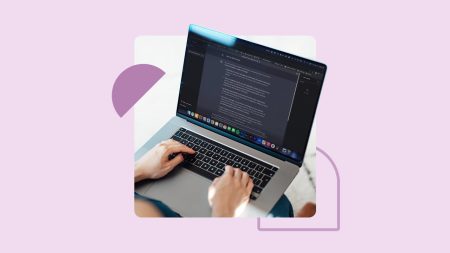alexsl/ Getty Images; Illustration by Austin Courregé/Bankrate
Key takeaways
- A lender or the federal government can garnish your wages if you fail to repay your loan.
- Some steps you can take to avoid wage garnishment include negotiating a new repayment plan or loan rehabilitation.
- Several options can help you avoid defaulting on your student loans, including forbearance or deferment.
Wage garnishment involves the lender or government automatically deducting a certain amount from your paycheck each month to repay the defaulted loan balance. When you default or miss a certain number of loan payments, the federal government or a private lender can garnish your wages.
Understanding how the wage garnishment process works depends on whether you have federal or private loans. Learning how wage garnishment works can help you avoid defaulting or get back on track.
Federal student loan wage garnishment
After your federal student loan is past due for 270 days or more, the federal government can garnish up to 15 percent of your disposable pay without a court’s permission. Not only that, the Social Security Administration can also withhold up to 15 percent of your Social Security income to cover delinquent student loan debt through the Treasury Offset Program. The federal government can also garnish other sources of income, including state and federal tax returns.
Private student loan wage garnishment
Private student loans generally go into default after three months of missed payments, though this can vary. Unlike federal student loans, a loan lender must get permission from a court to garnish your wages, meaning it must sue you and win a judgment. A private lender can garnish up to 25 percent of your weekly disposable income to repay federal student loans, depending on how much you earn and where you live.
Private lenders are limited in the types of income they can garnish. While they can garnish wages, these types of income are generally protected:
- Alimony
- Social Security
- Retirement
- Disability
Rights under wage garnishment
When it comes to wage garnishment, you have several rights, including:
- Notice before garnishment: Before the federal government garnishes your wages, the Department of Education (DOE) must send you a 30-day notice.
- Right to a hearing: Once the notice is sent, you have 30 days to request a hearing to explain why the government shouldn’t garnish your wages.
- Court order required for private student loans: The federal government can garnish your wages without a court order. However, if you default on a private student loan, the lender must win a court order against you.
- Federal limits: When you default on a federal student loan, the DOE can only garnish up to 15% of your disposable income.
4 ways to stop student loan wage garnishment
Once the federal government or a private lender starts garnishing your wages, it doesn’t have to continue indefinitely. You can take several steps to avoid wage garnishment on defaulted student loans.
1. Pay the full balance
Although easier said than done, especially if you have a substantial loan balance, paying off the defaulted loan amount in full can stop the government or private lender from garnishing your wages. If you’re unsure what the full balance is, contact your lender or loan servicer.
2. Negotiate repayment terms
To avoid wage garnishment relating to federal student loans, you can negotiate repayment terms with the U.S. Department of Education or the collection agency assigned to your account. For this to work, you must make your first payment no later than 30 days from the day the wage garnishment notice was sent.
Private lenders may also be willing to negotiate a repayment agreement or a loan settlement. Contact your lender for more information, as the requirements and availability will vary from lender to lender.
3. Request a hearing
With federal student loans, you may also decide to object to wage garnishment and ask for an official hearing. This could be your best option for the following scenarios:
- You do not agree about owing the student loan debt you’re being asked to pay.
- You disagree with the amount.
- You believe you weren’t properly notified about the garnishment.
You may also ask for a hearing if you believe that wage garnishment could create extreme financial hardship or if you’ve been employed for less than 12 months after losing a previous job. A potential downside is that in-person hearings for federal student loans are only available in San Francisco, Atlanta or Chicago. You’re also responsible for any costs associated with attending one. That said, a hearing can also be conducted by phone.
If your hearing is successful, either your wages won’t be garnished for a 12-month period or you may qualify for a partial (reduced) garnishment. If your hearing is unsuccessful, your wages will be garnished at 15 percent of your disposable income.
How to request a hearing
- Make a written request. Ensure your request is postmarked no later than 30 days from the date the wage garnishment notification was sent.
- Provide proof to support your objections to the debt or the garnishment and pay for your own legal representation for an in-person hearing. Many organizations offer help navigating this system, either free or for a fee.
4. Enter a rehabilitation agreement
If you have federal loans, you can get out of default through loan rehabilitation. With loan rehabilitation, you are asked to sign an agreement to make nine on-time monthly payments based on your income over a period of 10 consecutive months. To kick start the process of loan rehabilitation, you must contact your federal student loan servicer.
How to avoid student loan default
Student loan default can quickly become a costly mess, and that’s especially true once a collection agency gets involved. As a result, your best bet is avoiding default at all costs if you can.
If you’re worried about the future repayment of your student loans, here are some tips that can help:
- Look into deferment and forbearance. The federal government allows you to place your loans in forbearance or deferment — these options allow you to temporarily pause payments.
- Switch repayment plans to get a lower monthly payment. Several repayment plans are available for federal student loans, including extended repayment plans that can last up to 25 years. You may be able to get a lower monthly payment if you opt for a longer repayment term.
- Switch to an income-driven repayment plan. Federal student loans come with access to income-driven repayment plans that let you pay a percentage of your discretionary income toward federal loans for 20 to 25 years, at which point the remaining loan balances are forgiven. Considering your monthly payment could be as low as $0 on these plans, they can be a good option for borrowers with low incomes who are struggling to repay their loans.
- Refinance your student loans. Consider refinancing your student loans to get a lower interest rate, a lower monthly payment or both. Just remember that refinancing federal loans with a private lender means giving up federal protections like deferment, forbearance and access to income-driven repayment plans.
Bottom line
The federal government can garnish your wages or other sources of income, such as Social Security after you default on a student loan. Private lenders, on the other hand, can only garnish your wages with a court’s permission.
If your wages are being garnished for defaulting on a federal student loan, there are several actions you can take to stop it, including loan rehabilitation or requesting a hearing. For private student loans, you can try negotiating with the lender or debt collector to stop a garnishment.
Read the full article here










